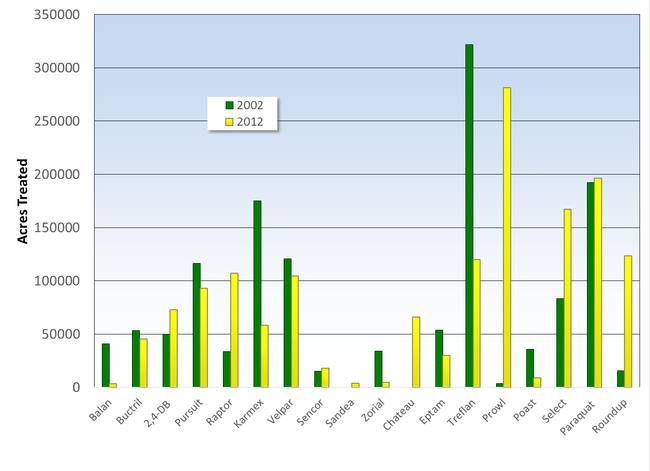The California Alfalfa Symposium was held last week for the first time ever in Long Beach to an audience of approximately 450 attendees. As usual, there was a wide range of alfalfa production, marketing and policy-related presentations. There were two weed-related presentations that might be of particular interest to weed practitioners and researchers. One presentation was Weed Management in Alfalfa: Where We've Been and Where We're Going by the author of this blog and another on New Herbicide Tools for Established Alfalfa by Farm Advisor Emeritus Mick Canevari. These were the best presentations of the entire conference! (Just kidding…of course.)
Information from these presentations is presented below. Most of the conference, including these two presentations, was videotaped. If you are interested the presentations, slide sets or proceedings papers go to http://alfalfa.ucdavis.edu/ where the information will be posted soon.
The herbicide registration timeline in California was reviewed to provide a historical perspective on weed management in alfalfa and to offer some insight as to where we may be headed in alfalfa weed control in the future. Many of the key herbicides that we rely on in California were actually registered before 1970. (Before 1970 the precise registration date was not recorded.) 2,4-DB, Gramoxone, Karmex, Sencor, and Roundup (used for stand take out at that time) were all registered pre 1970 and are still widely used in some areas of the state today. Buctril and Balan were registered in the 1970's. The early 80's saw the registration of some key herbicides including Treflan TR-10 and Velpar. Pursuit was registered in 1993 and quickly became the standard herbicide in seedling alfalfa. Select Max was also registered in that decade and is still widely used today. The early 2000's brought in the registration of Raptor, Chateau and Prowl H2O. The last new registration we saw in alfalfa was the registration of Prowl H2O in 2004 and even that was not a new active ingredient (the EC formulation of Prowl was registered over a decade earlier). So there have been a long drought—over 10 years—in new herbicide registrations. This is the longest time period without new registrations since alfalfa herbicides were first developed.
Herbicide use patterns in 2002 were contrasted with 2012 for several alfalfa production regions in California. The data showed the degree to which weed management systems and herbicide use patterns vary across the state, a reflection of the extreme diversity in alfalfa production environments that exist in California. There is nearly as much diversity in environments in California as there is across the entire U.S. Looking at the state as a whole, there are some clear changes in herbicide use in alfalfa (see Figure). Over this 10 year time period, the use of Pursuit has declined slightly and Raptor has become a prominent herbicide in seedling alfalfa. Both are still used to a high degree and are often tank mixed. Karmex use has dropped significantly, largely due to regulatory restrictions in Ground Water Protection Areas. Chateau has become an important winter dormant herbicide in some areas of the state. Treflan TR-10, largely used for summer grass control, has been largely replaced by Prowl H2O. Select has also become a widely used herbicide. Roundup has become the 5th most widely used herbicide in alfalfa, which is likely to escalate with the continual increase in the acreage of Roundup Ready (RR) alfalfa.
Possible reasons for the current drought in new alfalfa herbicide registrations were discussed. It is likely due to the increase in RR alfalfa, leaving a smaller potential market for new alfalfa herbicides. Another contributing factor is the ever-increasing cost of registering new products. It has been estimated that new herbicide development often takes 8 to 10 years and typically costs from $120 to $250 million dollars.
The next likely herbicide registrations in California are Aim (also called Shark or carfentrazone) and Sharpen (saflufenacil), which is used in other crops under the name Kixor, Treevix and other names. Research results with Sharpen and it potential fit in California alfalfa production systems was discussed. One of the main uses for Sharpen will be for common groundsel control in areas where this toxic weed is prevalent. Sharpen is a very effective burndown herbicide, typically causing a more complete burndown of the alfalfa than Gramoxone. Additional research is underway to define the optimum application window for effective weed control and to avoid crop injury.
It is promising to see some potential new herbicide registrations in alfalfa. However, it does definitely appear that the herbicide development pipeline has slowed substantially from the hay days (pun intended) of herbicide exploration. Moving forward we will likely need to continue finding techniques to fine-tune the use of time-honored standard alfalfa herbicides and find new uses for old herbicides registered in other crops.
